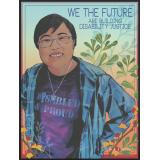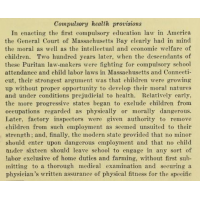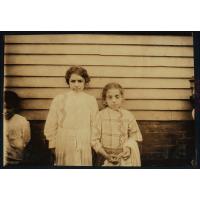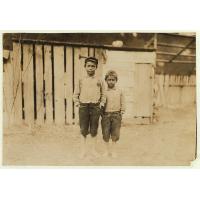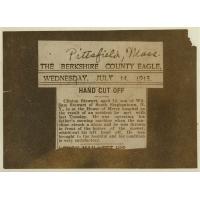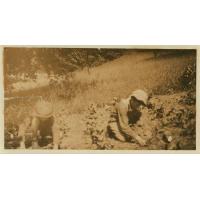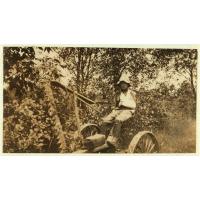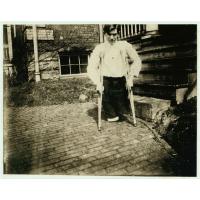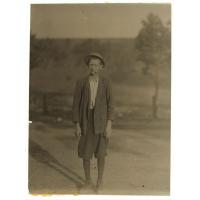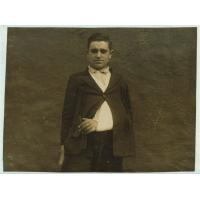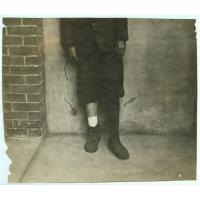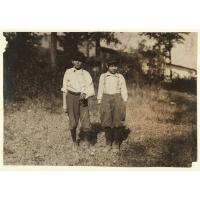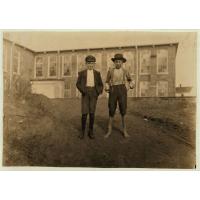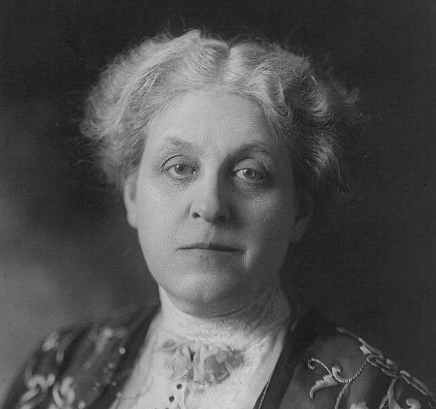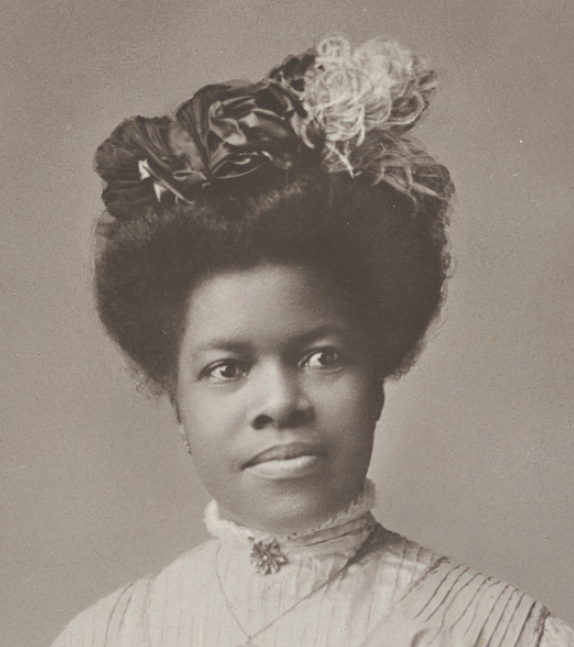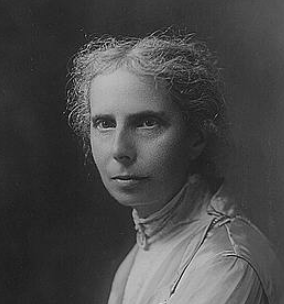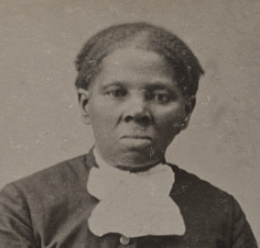This learning activity uses photographs from to look at child labor in the early 1900s. It asks students to think about how children worked through illness and injury as well as how the jobs themselves were disabling. This album takes a broad view of disability, including everything from permanent physical disabilities to temporary injuries to both acute and chronic illnesses. This is a purposefully large album to include a wide variety of experiences. Teachers can pick out one or two photos to analyze or they can split their class into groups to tackle the full set.
*Note: Before starting this exercise, discuss respectful language and historical terms (like crippled) which are considered offensive today.
Consider starting with the Observe, Reflect, Question approach to analyze the photographs.
For background information, I suggest looking at the National Child Labor Committee collection. There are also two lesson plans about child labor on the LOC website (Child Labor in America & Child Labor and the Building of America), but neither of them confronts the role disability played in these children's lives like this album does.
----
Potential Discussion Questions
- What were some of the dangers children encountered while working? (In what ways were these workplaces disabling?) Be specific.
- How did disability, injury, and illness shape children’s work lives in the early 1900s? Choose specific examples from the photographs and captions to support your answer.
- What are the differences between what happens when these children got sick or injured versus what happens in your life?
- What do you think these children were feeling? What can you infer from their facial expressions and body language?
- How did these photos (and captions) help reformers efforts for protective child labor laws?
Discussion questions on health examinations
- Why did child labor activists advocate for state laws that required health examination for child workers?
- How did the photos of child workers help support these reform efforts?
- What might have been some of the unintended negative consequences of such examinations?
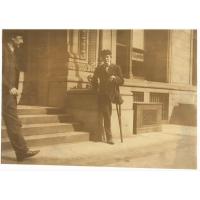 National Child Labor Committee No. 954. 1-legged boy. Neil Gallagher, Wilkes Barre, Pa. Born January 14, 1891. Went to work at about 9 years. Worked about two years in breaker. Went inside at about 11 years. "Tripper," tending door. 83 cents [a] day. Injured May 2, 1904. Leg crushed between cars. Amputated at Mercy Hospital, Wilkes Barre. "Baltimore Tunnell" - "Black Diamond" D. & H. Co. Thomas Lewellin Superintendent (inside boys); Samuel Morgan, Superintendent. In Hospital 9 weeks. Amputated twice. No charge. Received nothing from company. "Was riding between cars and we aren't supposed to ride between them." No written rules, but they tell you not to. Mule driver (who was on for first day) had taken his lamp and he tried to reach across car to get it. Slipped between bumpers. Been working in breakers since. Same place $1.10 a day. Work only about 1/2 time. Work about 6 hour day. Left 3 months ago. Been in N.Y. - no work. Trying to get work in Poolroom. Applicant at Bureau for Handicapped, 105 E. 22nd Stree
National Child Labor Committee No. 954. 1-legged boy. Neil Gallagher, Wilkes Barre, Pa. Born January 14, 1891. Went to work at about 9 years. Worked about two years in breaker. Went inside at about 11 years. "Tripper," tending door. 83 cents [a] day. Injured May 2, 1904. Leg crushed between cars. Amputated at Mercy Hospital, Wilkes Barre. "Baltimore Tunnell" - "Black Diamond" D. & H. Co. Thomas Lewellin Superintendent (inside boys); Samuel Morgan, Superintendent. In Hospital 9 weeks. Amputated twice. No charge. Received nothing from company. "Was riding between cars and we aren't supposed to ride between them." No written rules, but they tell you not to. Mule driver (who was on for first day) had taken his lamp and he tried to reach across car to get it. Slipped between bumpers. Been working in breakers since. Same place $1.10 a day. Work only about 1/2 time. Work about 6 hour day. Left 3 months ago. Been in N.Y. - no work. Trying to get work in Poolroom. Applicant at Bureau for Handicapped, 105 E. 22nd Stree
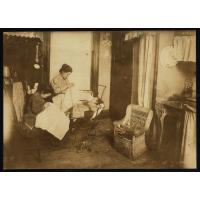 309 W. 146th Street. [...] and her seven year old daughter, Lorenza, embroidering ladies waists in their dirty kitchen-living room. Lorenza makes the stems of the flowers. Her mother said, "See how smart she is. I show her how and right away she makes them." "She is so little because she's been sick so much.["] She works after school. Father is out of a job. "They pay too cheap for lace." Said they make about $2.00 a week. Location: New York, New York (State)
309 W. 146th Street. [...] and her seven year old daughter, Lorenza, embroidering ladies waists in their dirty kitchen-living room. Lorenza makes the stems of the flowers. Her mother said, "See how smart she is. I show her how and right away she makes them." "She is so little because she's been sick so much.["] She works after school. Father is out of a job. "They pay too cheap for lace." Said they make about $2.00 a week. Location: New York, New York (State)
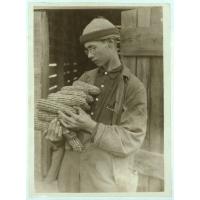 A Product of the 4 H. Club. Gradie Walton, 17 yrs. old, - is very deficient in most school branches (except in mathematics where he shines). He is much handicapped physically, - lost one eye in an accident and the other is weak. This year he raised 135 bushels of corn on one acre (his father raised about one half as much and complained that the boy's land was better). The secret was that the boy worked hard on the plot, - fertilizing and cultivating, even bringing soil in from the woods. He got the First Prize for two years. Location: Pocahontas County, West Virginia / Photo by Lewis W. Hine.
A Product of the 4 H. Club. Gradie Walton, 17 yrs. old, - is very deficient in most school branches (except in mathematics where he shines). He is much handicapped physically, - lost one eye in an accident and the other is weak. This year he raised 135 bushels of corn on one acre (his father raised about one half as much and complained that the boy's land was better). The secret was that the boy worked hard on the plot, - fertilizing and cultivating, even bringing soil in from the woods. He got the First Prize for two years. Location: Pocahontas County, West Virginia / Photo by Lewis W. Hine.
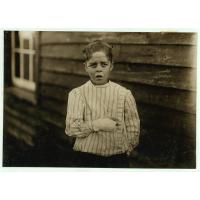 Accident to young mill worker. Giles Edmund Newsom (Photo October 23rd, 1912) while working in Sanders Spinning Mille [i.e., Mill], Bessemer City, N.C., August 21st, 1912, a piece of the machine fell on to his foot mashing his toe. This caused him to fall on to a spinning machine and his hand went into unprotected gearing, crushing and tearing out two fingers. He told the Attorney he was 11 years old when it happened. His parents are now trying to make him 13 years old. The school census taken at the time of the accident makes him12 years old (parents' statement) and school records say the same. His school teacher thinks he is 12. His brother (see photo 3071) is not yet 11 years old. Both of the boys worked in the mill several months before the accident. His father, (R.L. Newsom) tried to compromise with the Company when he found the boy would receive the money and not the parents. The mother tried to blame the boys for getting jobs on their own hook, but she let them work several months. The aunt said "Now h
Accident to young mill worker. Giles Edmund Newsom (Photo October 23rd, 1912) while working in Sanders Spinning Mille [i.e., Mill], Bessemer City, N.C., August 21st, 1912, a piece of the machine fell on to his foot mashing his toe. This caused him to fall on to a spinning machine and his hand went into unprotected gearing, crushing and tearing out two fingers. He told the Attorney he was 11 years old when it happened. His parents are now trying to make him 13 years old. The school census taken at the time of the accident makes him12 years old (parents' statement) and school records say the same. His school teacher thinks he is 12. His brother (see photo 3071) is not yet 11 years old. Both of the boys worked in the mill several months before the accident. His father, (R.L. Newsom) tried to compromise with the Company when he found the boy would receive the money and not the parents. The mother tried to blame the boys for getting jobs on their own hook, but she let them work several months. The aunt said "Now h
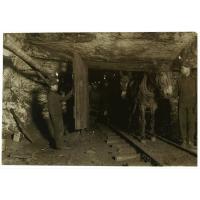 Holding the door open while a trip[?] goes through. Willie Bryden, a nipper, 164 Center St. A lonely job. Waiting all alone in the dark for a trip to come through. It was so damp that Willie said he had to be doctoring all the time for his cough. A short distance from here, the gas was pouring into the mine so rapidly that it made a great torch when the foreman lit it. Willie had been working here for four months, 500 feet down the shaft, and a quarter of a mile underground from there. (Shaft #6 Pennsylvania Coal Co.) Walls have been whitewashed to make it lighter. January 16th, I found Willie at home sick, His mother admitted that he is only 13 yrs old; will be 14 next July. Said that 4 mos. ago the mine boss told the father to take Willie to work, and that they obtained the certificate from Squire Barrett. (The only thing the Squire could do was to make Willie out to be 16 yrs old.) Willie's father and brother are miners and the home is that of a frugal German family. Location: Pittston, Pennsylvania.
Holding the door open while a trip[?] goes through. Willie Bryden, a nipper, 164 Center St. A lonely job. Waiting all alone in the dark for a trip to come through. It was so damp that Willie said he had to be doctoring all the time for his cough. A short distance from here, the gas was pouring into the mine so rapidly that it made a great torch when the foreman lit it. Willie had been working here for four months, 500 feet down the shaft, and a quarter of a mile underground from there. (Shaft #6 Pennsylvania Coal Co.) Walls have been whitewashed to make it lighter. January 16th, I found Willie at home sick, His mother admitted that he is only 13 yrs old; will be 14 next July. Said that 4 mos. ago the mine boss told the father to take Willie to work, and that they obtained the certificate from Squire Barrett. (The only thing the Squire could do was to make Willie out to be 16 yrs old.) Willie's father and brother are miners and the home is that of a frugal German family. Location: Pittston, Pennsylvania.
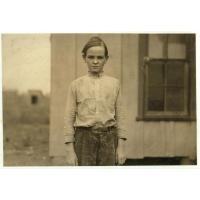 Charlie Lott a thirteen year old doffer in cotton mill at West. His Family Record says born March 12, 1900. Has been working for a year in the mill at Laurel, Miss. Came here recently and was put to work at once although he was in bad shape physically. Maybe malaria, maybe hookworm. Location: West, Texas.
Charlie Lott a thirteen year old doffer in cotton mill at West. His Family Record says born March 12, 1900. Has been working for a year in the mill at Laurel, Miss. Came here recently and was put to work at once although he was in bad shape physically. Maybe malaria, maybe hookworm. Location: West, Texas.
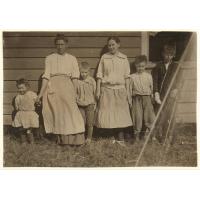 A menace to Society. The Padgett family. The entire family including the mother totally illiterate. No one could read or write. The mother does mill work some. Alice, 17 years has steady job. Makes from $5 to $6 a week. Alfred, 13 years now, worked here when he was 12, and in other mills before that. Makes $4 a week. Recently crippled by getting his hand caught in the cogs of a spinning machine. Richard just reached 11. Been working here 1 year; began when he was 10. Makes $2.40 a week. "The work runs him down too." William, 6 years old, nearly blind. Lizzie, 5 years old. Home in utter neglect; filthy and bare. When investigator called the mother had been gone about an hour, leaving a roomer's 3 months old baby in the cradle before an open fire on the hearth, and only two children 5 and 6 years old - one nearly blind, playing around. She came back and fed them a lot of cheap candy. What will Society reap from its neglect of this family? Shaw Cotton Mills. Location: South Weldon, North Carolina.
A menace to Society. The Padgett family. The entire family including the mother totally illiterate. No one could read or write. The mother does mill work some. Alice, 17 years has steady job. Makes from $5 to $6 a week. Alfred, 13 years now, worked here when he was 12, and in other mills before that. Makes $4 a week. Recently crippled by getting his hand caught in the cogs of a spinning machine. Richard just reached 11. Been working here 1 year; began when he was 10. Makes $2.40 a week. "The work runs him down too." William, 6 years old, nearly blind. Lizzie, 5 years old. Home in utter neglect; filthy and bare. When investigator called the mother had been gone about an hour, leaving a roomer's 3 months old baby in the cradle before an open fire on the hearth, and only two children 5 and 6 years old - one nearly blind, playing around. She came back and fed them a lot of cheap candy. What will Society reap from its neglect of this family? Shaw Cotton Mills. Location: South Weldon, North Carolina.
Replies displayed by creation date
Ellie - Such powerful stories!
I would add a version of my ever recurring question: Who is responsible to protect and care for children? Clearly Hine had a perspective on that question. Changing ideas about the answer show much about how American society adapted to industrialization and urbanization. Answers continue to change today.
That's a great question! And one I hadn't thought about before, but it's so relevant.
These images and the newspaper clips are so powerful. What a great and thorough album. I think that the visuals will really help young learners understand how dangerous child labor was/is and the importance of child labor laws. There will be some important reflections and realizations about how many children spend their free time today vs. in the past. Mother Jones and Her Army of Mill Children is a 2020 nonfiction picture book about child labor that would fit nicely with this album/lesson.
Oh wow, what a cool book! Thanks for sharing
Testimonials
- I love that there is new info on the site daily!
- I had a wonderful time working with the Library of Congress and learning about all of the resources at my fingertips!
- The TPS Teachers Network has an equal exchange of ideas. You know it's not a place where you're being judged.
- My colleagues post incredibly fine resources and ideas....the caliber of the suggestions and resources make me feel that I take a lot from it. It's a takeaway. And I hope that I can give back as much as I get.
- Going into this school year, I have a fantastic new resource for my own instruction and to share with my colleagues!
- I am very glad that I discovered the TPS Teachers Network through RQI. Great resources can be hard to find out there on the internet!

